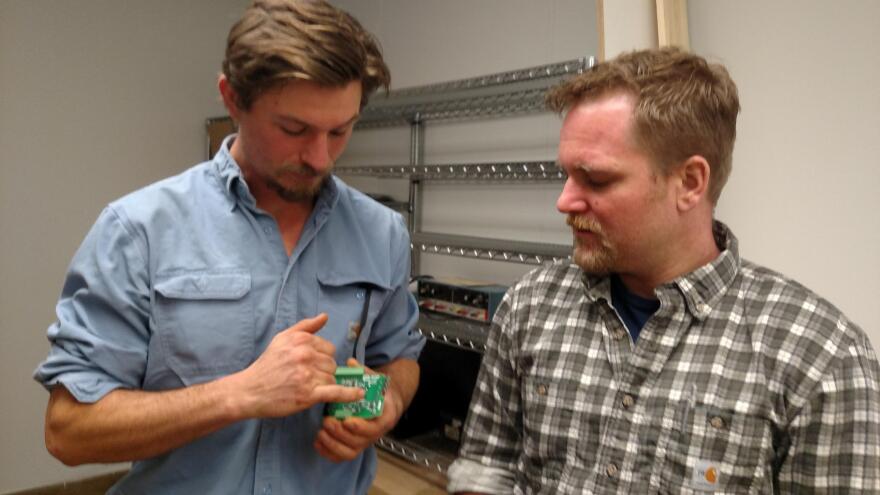Engineers at UAF’s Alaska Center for Energy and Power have invented a device that should help promote greater use of renewable-energy sources such as wind and hydropower to generate electricity in small, remote communities. Center officials say development of the ST100 is an important milestone in their effort to boost the use of renewables to help communities save money by burning less diesel fuel to generate power.
The ST100 is only about the size of a deck of cards. But as Alaska Center for Energy and Power engineer Marc Mueller-Stoffels showed off the little component, he said it represents a big step toward the center’s goal of developing technologies to enable greater use of renewable energy in the so-called microgrids that distribute electricity in remote Alaskan communities located far off the main grid.
“This is one part of a big, big effort to make these grids stable, provide high-quality power to the customers at least cost,” Mueller-Stoffels said. “That’s ACEP’s mission, to help with solutions to that.”
Muller-Stoffels said the ST100 will help the Center’s Power Systems Integration lab test systems solve a major problem that arises when combining electricity from renewable-energy sources such as wind and hydropower into microgrids that get most of their electricity from diesel-fueled generators. The problem is fluctuations in the flow of electricity from a renewable-power source, like a wind generator, when winds gust or die down. Those can cause brownouts and even system failures.
“A lot of renewable energy is also very variable,” Jeremy Vandeermer said. Vndermeer is a research engineer with the power systems integration program who headed up development of the ST100, or as Mueller-Stoffels jokingly calls it, “The Vandemeer 10,000.”
That’s a reference to 10,000 hertz, the speed at which the ST100 can measure and transmit data from sensors on a renewable-energy generator that indicates it’s slowing down or speeding up to a control unit that would use that data to increase or decrease output from a diesel-fired generator.
Vandermeer said that function requires an advanced control system to integrate power from both sources onto a microgrid smoothly and efficiently. And that in turn requires a component that would enable data to be instantaneously relayed from the renewable-energy generator to the control system.
“You need to be able to have a quick response time,” Vandermeer said. “And for us, too, we need this data from grids to run emulations and simulations in our laboratory.”
Vandermeer developed the ST100, which he calls a signal isolator/translator, over two-and-a-half years. He began working on it after the lab’s engineers found off-the-shelf components didn’t provide sufficient data quickly enough to solve the intermittent-power problem.
“So we basically had to come up with one of our own,” Vandermeer said.
Vandermeer built a prototype to the ST100, which can transmit signals a thousand times faster than commercially available signal isolator/translator.
Vandermeer said he built it with a basic circuit board and a handful of semiconductors, resistors and capacitors, using both high-tech and low-tech tools to get the job done.
“We had a little hot plate for making sausages and eggs for breakfast, and we made it on there,” Vandermeer said with a chuckle.
Mueller-Stoffels, who manages the Center’s Power Systems Integration program, said he’s just received 20 ST100s he’d ordered for use in testing renewable energy-powered electricity-generating systems. The first test will be conducted soon on a so-called hydrokinetic turbine that’s powered by the flow of river water. Engineers with the Center have beenfield-testing the systemin the Tanana River near Nenana over the past year. And they brought the turbine back to lab on the UAF campus for more testing.
“Because a big project in our laboratory right now is to integrate that generator with an inverter and a battery to give it a full-grid interface, so it can actually generate power and deliver that power into a village grid,” Mueller-Stoffels said.
Mueller-Stoffels said the lab is working with the university’sOffice of Intellectual Property and Commercialization to try and recoup revenue, probably in the form of licensing fees, when ACEP makes the ST100’s technology publicly available.


